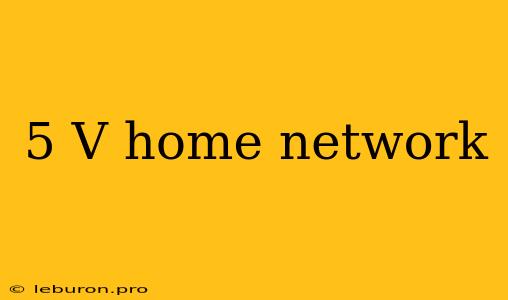In the realm of home networking, the 5V home network has emerged as a game-changer, revolutionizing the way we connect our devices and access the internet. With its impressive speed, reliability, and versatility, the 5V home network has become the preferred choice for tech-savvy individuals and families alike. This article delves into the intricacies of a 5V home network, exploring its key features, benefits, and implementation strategies.
Understanding the 5V Home Network
At its core, a 5V home network refers to a network infrastructure that leverages a 5-volt power supply for its operation. Unlike traditional networks that rely on higher voltages, the 5V network utilizes a lower voltage, leading to several advantages. The 5V power supply is commonly found in various electronic devices, such as smartphones, tablets, and laptops, making it an accessible and readily available resource for home networking.
Key Features of a 5V Home Network:
- Low Power Consumption: The reduced voltage in a 5V network translates to lower power consumption, resulting in reduced energy bills and a more environmentally friendly setup.
- Enhanced Safety: The lower voltage minimizes the risk of electrical shocks, making it a safer option for families with young children or pets.
- Improved Signal Strength: The 5V network boasts improved signal strength, ensuring reliable connectivity throughout your home.
- Increased Data Transfer Rates: With its high bandwidth capacity, the 5V network facilitates faster data transfers, enhancing streaming, gaming, and online work experiences.
Benefits of a 5V Home Network:
- Cost-Effective: Utilizing readily available 5V power supplies significantly reduces the cost of building and maintaining a home network.
- Ease of Setup: The 5V network is relatively easy to set up and configure, even for individuals with limited technical expertise.
- Scalability: As your network demands grow, you can easily scale the 5V network by adding more devices and components without sacrificing performance.
- Flexibility: The 5V network offers flexibility in terms of device placement and connectivity options, allowing you to tailor it to your specific needs.
Implementing a 5V Home Network:
- Choosing the Right Equipment: Select compatible 5V network devices, including routers, switches, and access points, to ensure optimal performance.
- Cable Management: Utilize high-quality cables to minimize signal interference and ensure stable connections.
- Network Security: Implement strong security measures, such as passwords and firewalls, to protect your network from unauthorized access.
- Regular Maintenance: Perform regular network maintenance to ensure smooth operation and identify potential issues early on.
Conclusion:
The 5V home network offers a compelling solution for modern-day networking needs. Its lower power consumption, enhanced safety, improved signal strength, and cost-effectiveness make it a highly attractive option for individuals and families seeking a reliable and efficient home network. As technology continues to advance, the 5V home network is poised to become the standard for future home networking solutions. By embracing the benefits of this innovative technology, we can unlock the full potential of our connected homes and enjoy a seamless online experience.
